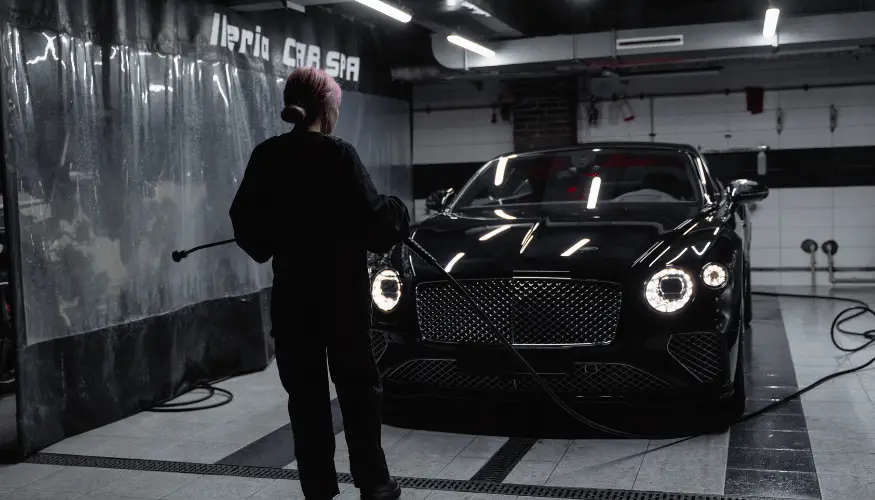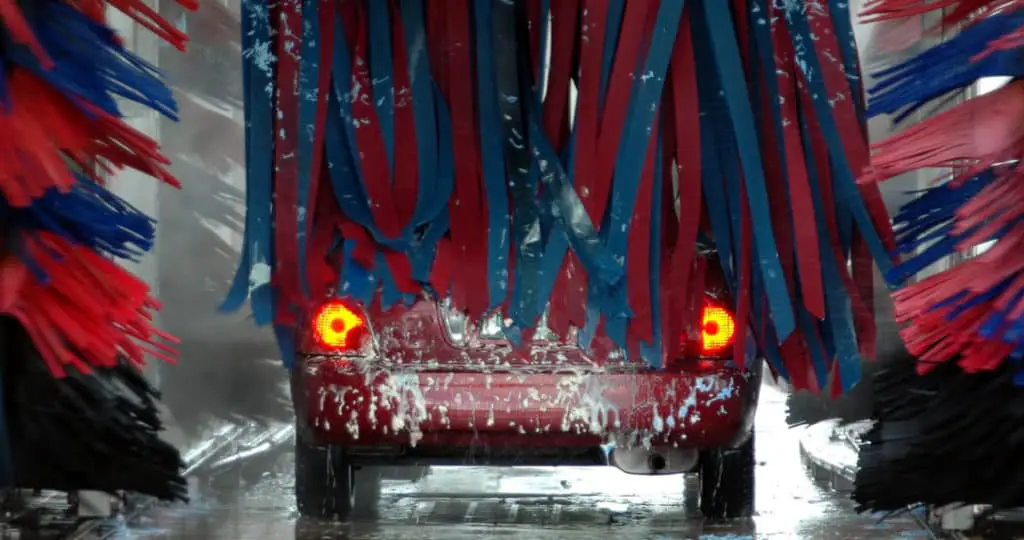- How to Clean Car Carpets Quickly (Without An Extractor) - July 10, 2024
- Can You Touch Up Clear Coat On A Car? Yes and No (Here’s Why) - November 25, 2023
- How To Wax A Car By Hand (For Beginners) - November 14, 2023
Last Updated on January 16, 2025 by Nate Schnell
Ceramic coating has become the talk of the automotive world, offering a sleek, glossy shield that keeps your car looking pristine. But is it really as impressive as its reputation suggests? While some car owners rave about its durability and shine, others wonder if it’s worth the investment. Let’s take a closer look at how ceramic coatings work, what they offer, and whether they’re the right choice for your vehicle.
What Exactly Is Ceramic Coating?
Think of ceramic coating as a protective shield for your car’s paint. It’s a liquid polymer that bonds to the clear coat of your car, creating a long-lasting layer that resists dirt, UV rays, and minor scratches. Unlike traditional waxes that sit on top of the paint and wear off quickly, ceramic coating bonds at a molecular level, offering stronger and longer-lasting protection.
When applied and cured, it forms a hardened surface that makes water bead up and roll off, taking grime and dust along with it. The result? A high-gloss finish that turns heads and keeps your car easier to clean.
How Does It Work?
The ceramic coating process involves applying the liquid formula to the paint, where it chemically bonds to create a hydrophobic (water-repelling) and protective layer. This layer prevents contaminants from embedding into the paint, helping to avoid water spots, bird droppings, and bug splatters from causing permanent damage.
The key to its effectiveness lies in preparation. The surface must be thoroughly cleaned, clayed, and polished to ensure the coating adheres perfectly. Any imperfections left on the paint will be locked in under the coating.
What Are the Benefits of Ceramic Coating?
One of the main reasons drivers opt for ceramic coating is the convenience it offers. But there’s more to it than just a shiny surface.
For starters, ceramic coatings are highly resistant to oxidation and sun damage. If you live in an area with intense sunlight, the coating protects your car’s paint from fading and discoloration. It’s also ideal for rainy climates, as the hydrophobic surface makes rain and mud slide off instead of sticking.
Another benefit is its scratch resistance. While ceramic coatings won’t make your car scratch-proof, they do provide a buffer that helps prevent light scratches and swirl marks from forming.
But perhaps the biggest draw is the easy maintenance. Since ceramic coatings resist dirt and grime, washing your car becomes a breeze—no need for excessive scrubbing or frequent waxing sessions.
The Potential Downsides
Like any product, ceramic coating has its drawbacks, and it’s important to weigh these before making a decision.
The most notable downside is the cost. Professional ceramic coating can cost anywhere from $500 to $2,000 or more, depending on the size of your vehicle and the extent of prep work required. It’s a significant investment, especially when compared to a basic wax job.
The application process is also time-intensive. It requires meticulous prep, and the coating must cure properly to achieve its full potential. This means leaving your car at the shop for a day or two.
Additionally, while ceramic coatings offer some scratch resistance, they’re not invincible. Heavy scratches, dings, or impacts can still penetrate the coating and damage the paint beneath. And once the coating wears down or becomes damaged, it may need to be reapplied.
What Happens If You Neglect Your Ceramic Coating?
Skipping regular maintenance can reduce the coating’s effectiveness. Dirt, sap, and bird droppings left on the surface for too long can dull the finish and cause staining. Improper washing techniques, like using abrasive sponges or automatic car washes, can introduce micro-scratches that weaken the coating.
Without proper care, your ceramic coating can lose its hydrophobic properties, meaning water and grime won’t bead and slide off as they should. Instead, contaminants will stick, making your car harder to clean.
Is It Worth the Price Tag?
To decide if ceramic coating is worth it, consider your goals, budget, and driving habits.
If you’re someone who takes pride in keeping your car spotless and plans to own it for several years, ceramic coating can be a valuable investment. Its longevity and protective features can save you money on frequent detailing and wax treatments.
However, if you’re more concerned about upfront cost or you drive an older car that’s already seen its fair share of wear and tear, ceramic coating might feel like an unnecessary expense. In that case, traditional wax or a paint sealant might be a more practical choice.
Alternatives to Ceramic Coating
If ceramic coating feels like too much of a commitment, there are other options to consider:
- Paint Protection Film (PPF): This clear, durable film offers exceptional protection against rocks, debris, and scratches. It’s more expensive than ceramic coating but provides superior impact resistance.
- Synthetic Sealants: These provide a good level of protection at a lower cost and can last several months before needing reapplication.
- Traditional Wax: The most affordable option, but it requires frequent reapplication—usually every two to three months.
DIY vs. Professional Application
Ceramic coatings are available in consumer-grade kits that cost between $50 and $150. While these can be a fun DIY project for car enthusiasts, the process isn’t as simple as spraying and wiping. DIY applications require meticulous prep work and patience, and mistakes can lead to streaks or uneven coverage.
Professional application, though more expensive, ensures that the coating is applied correctly and that any imperfections in the paint are corrected beforehand. If you’re not confident in your ability to apply the coating yourself, hiring a professional can be worth the peace of mind.
Maintaining Your Ceramic Coating
Once your ceramic coating is applied, it’s crucial to maintain it properly:
- Stick to pH-Neutral Shampoos: Avoid harsh soaps that can strip the coating’s properties.
- Wash Regularly: Prevent the buildup of contaminants by washing your car every one to two weeks.
- Avoid Automated Car Washes: The brushes can cause micro-abrasions that weaken the coating.
- Use Soft, Clean Towels: Dry your car with microfiber towels to prevent scratches.
Final Thoughts
Ceramic coating offers exceptional protection, convenience, and aesthetic appeal for car owners who want their vehicles to look their best. While the upfront cost can be steep, the long-term benefits often outweigh the investment—especially for those who value low-maintenance upkeep and enhanced paint protection.
Ultimately, the choice comes down to your preferences, budget, and how much effort you’re willing to put into maintaining your car. If you’re ready to commit to proper care, ceramic coating can keep your car looking sleek and shielded from the elements for years to come. But if you’re hesitant about the cost or maintenance, alternatives like wax or paint sealants can still offer impressive results without the hefty price tag.



